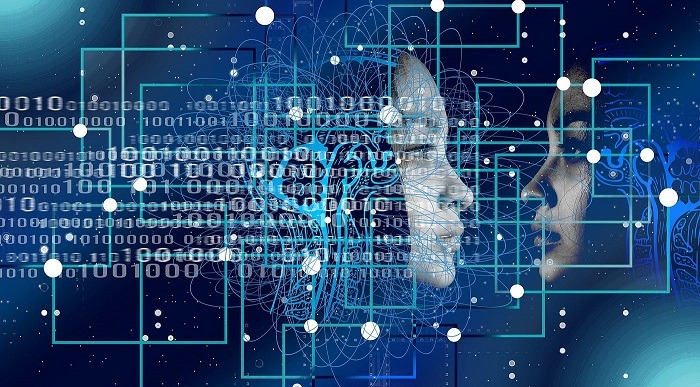People often confuse machine learning (ML) and artificial intelligence (AI), but the terms have meaningful differences. Artificial intelligence (AI) and machine learning (ML) are two powerful technologies that are being used in a wide range of industries today. AI is a broad field that aims to create intelligent machines, while ML is a subset of AI that focuses on teaching machines to learn from data.
In this article, we will explore how AI and ML are used in the world today and discuss the benefits of each technology.
What is Artificial Intelligence (AI)?
Artificial intelligence (AI) is computer software that can think and learn like humans, allowing it to do complex tasks that were once only possible for humans, such as making decisions, analyzing data, and translating languages.
AI is computer code that can learn and do things that require human reasoning, such as making decisions and solving problems. Unlike automated machines and systems, which simply follow a set of instructions without change, AI systems can learn from their interactions and improve their performance over time.
AI is a broad term that encompasses many different interrelated fields, each with its own focus. Some of the most common subfields of AI include:
- Machine learning: Machine learning is a subset of AI that allows computers to learn without being explicitly programmed. Instead, machine learning algorithms are trained on data sets to become machine learning models capable of performing specific tasks.
- Deep Learning: Deep learning is a subset of ML that uses artificial neural networks (ANNs) to learn from data and perform complex reasoning tasks without human intervention. Deep learning algorithms are used in a wide variety of applications, including image recognition, speech recognition and more.
- Natural language processing (NLP): NLP is a subset of computer science, AI, linguistics, and ML that focuses on creating software capable of interpreting human communication. NLP algorithms can be used to translate languages, generate text, and answer questions in a human-like way.
- Computer vision: Computer vision is a subset of AI that allows computers to interpret and analyze the visual world, simulating the way humans see and understand their environment. It applies machine learning models to identify and classify objects in digital images and videos, then lets computers react to what they see.
- Robotics: Robotics is a subset of AI, computer science, and electrical engineering focused on creating robots capable of learning and performing complex tasks in real world environments. Robotics algorithms can be used to develop robots that can perform tasks such as walking, grasping objects, and navigating complex environments.
What is Machine learning (ML)?
Machine learning (ML) is a subfield of artificial intelligence focused on training computers to learn from data and make decisions without being explicitly programmed to do so. ML algorithms are typically trained on large amounts of data, and they learn from the data to make predictions about new data.
Data is essential for ML algorithms. Without data, ML algorithms cannot learn and improve. The quality and quantity of the data that is used to train a machine learning algorithm has a big impact on the performance of the algorithm.
Machine learning algorithms can be used to solve a wide variety of problems, but they are only as good as the data that they are trained on. If the data is not representative of the real world, then the machine learning algorithm will not be able to make accurate predictions about new data.
There are three main types of machine learning:
- Supervised learning: Supervised ML learns patterns and relationships between input and output data. It is defined by its use of labeled data. A labeled data is a dataset that contains a lot of examples of Features and Target. Supervised learning uses algorithms that learn the relationship of Features and Target from the dataset.
- Unsupervised learning: In unsupervised learning, we do not have a labeled dataset. The machine learning algorithms analyze and cluster unlabeled datasets. These algorithms discover hidden patterns or data groupings without the need for human intervention. Its ability to discover similarities and differences in information make it the ideal solution for exploratory data analysis, cross-selling strategies, customer segmentation, and image recognition.
- Semi-supervised learning: Semi-supervised learning is a combination of supervised learning and unsupervised learning. We have a dataset with some labeled data and some unlabeled data. We train the machine learning algorithm on the labeled data, and the algorithm then uses this knowledge to learn from the unlabeled data.
Machine learning is the primary way that people interact with artificial intelligence today. Here are some examples of how you might have encountered machine learning before:
- Watching videos on an online streaming platform: Machine learning algorithms recommend videos to you based on your past viewing history and other factors.
- Getting help from a chatbot online: Chatbots use machine learning to understand your questions and provide you with the information you need.
- Using a virtual assistant: Virtual assistants use machine learning to understand your requests and complete tasks on your behalf, such as scheduling meetings, playing music, and making phone calls.
What’s the difference between machine learning and AI?
Artificial intelligence (AI) is computer software that mimics the ways that humans think, in order to perform complex tasks, such as analyzing data, reasoning, and learning. Machine learning (ML) is a subset of AI that uses algorithms trained on data to create models that can perform these complex tasks.
Most AI is powered by machine learning, so the two terms are often used interchangeably. But AI is actually the broader concept of creating human-like intelligence using computers, while machine learning is just one way to do that.
Artificial Intelligence Use Cases
- Self-driving cars: Self-driving cars use AI to perceive their surroundings, make decisions, and control the vehicle. AI algorithms are used to process data from sensors such as cameras, radar, and lidar to create a 3D map of the environment. AI algorithms are also used to make decisions about how to navigate the vehicle safely and efficiently.
- Medical diagnosis: AI is being used to help doctors diagnose diseases more accurately and efficiently. AI algorithms can be trained on large datasets of medical images and patient records to identify patterns and correlations that human doctors may not be able to see. AI algorithms can also be used to develop new diagnostic tools and treatments.
- Fraud Detection: AI is being used to develop systems that can detect fraudulent transactions and other types of financial fraud. For example, AI systems can be used to analyze customer data to identify patterns that may indicate that a customer is at risk of fraud. AI can also be used to analyze transaction data to identify fraudulent transactions.
Benefits of AI
AI and machine learning offer many benefits to businesses and consumers alike. For consumers, this can mean more personalized services, while businesses can expect reduced costs and improved operational efficiency.
Here are some common benefits for businesses that use AI and machine learning:
- Improved data analysis: AI and machine learning have ability to quickly analyze large amounts of data to produce actionable insight.
- Reduced costs and Increased ROI: AI and machine learning can automate many tasks that are currently performed by humans. This can free up employees to focus on more strategic initiatives and help businesses save money on labor costs.
- Increased operational efficiency: AI and machine learning can help businesses streamline their operations and improve their efficiency.
- Improved customer satisfaction: AI and machine learning can help businesses better understand their customers and provide them with more personalized experiences. This can lead to increased customer satisfaction and loyalty.
Conclusion
Artificial intelligence (AI) and machine learning (ML) are two powerful technologies that are being used to solve a wide range of problems today. AI is a broad field that aims to create intelligent machines, while ML is a subset of AI that focuses on teaching machines to learn from data.
AI and ML are essential technologies for the future. They are helping us to solve some of the world’s biggest challenges and are creating new opportunities in all industries.

